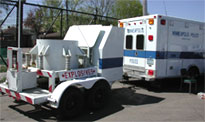 On On
August 14. 1923, Minneapolis police motorcab inspector Emil Engstrom
and L.W. Taylor, president of the Red Top Cab Company, had been tipped
off that a William Stauffer, who was a driver for Red Top Cab, was the
man who was involved in the holdup of a bakery wagon, where the driver
was beaten and robbed. Acting on this tip, the
two men were out cruising around the streets looking for Stauffer. They
spotted him walking along Grant Street near Fifth Avenue South, and
approached him. Taylor swung his car toward the curb and Patrolman
Engstrom leaped out, calling “I want to talk to you” to Stauffer. As he stepped forward, Stauffer, sensing their mission, whipped out a pistol and fired. Engstrom, fell, mortally wounded. “I
shouted, ‘You’ve killed him,'” Taylor later told police. “Then I jumped
toward him. He fired once more, and I fell. I could see him run down
the street, waving the pistol in his hand.” The gunman ran toward Fifteenth and Nicollet, dodged behind a passing motorcar and disappeared. Taylor
staggered down the street and was met by a motorcab driver who was
passing by. Taylor was able only to point toward Patrolman Engstrom’s
body, lying on the sidewalk, before he himself collapsed. The
driver lifted Engstrom into his cab, halted a passing car and saw that
Taylor was started toward the hospital before he sped Engstrom to the
General hospital. Patrolman Engstrom was shot through
the neck and died at the General hospital, three hours after the
shooting, when a blood transfusion failed to give him strength. A
moment before he died, Engstrom identified Stauffer as the man who shot
him. Taylor was critically wounded with a gunshot in
the right side. The bullet lodged near his right lung. Surgeons
reported that he had better than an even chance for recovery. A
massive manhunt for Patrolman Engstrom’s killer centered in and near
the Minneapolis loop district, as citizens and police sought William
Stauffer. The police were under orders to “shoot to kill,” but found no
definite clues to the whereabouts of the murderer. Patrolmen
who worked with Engstrom at the central station collected a fund of
$100.00, to be offered as a reward for the capture of the slayer. The
Ku Klux Klan announced a contribution of $100.00 toward a fund as a
reward for Stauffer’s capture. One hundred cards
bearing Stauffer’s description and photograph were distributed to
precinct stations and surrounding towns. Radio stations broadcast
descriptions of the man. Every announcement included the warning “He
will shoot to kill if cornered.” Efforts of Captain of
Detectives Walter E. Bryant were centered on proving a connection
between Stauffer, a disgruntled war veteran and narcotic addict, and
the drug-crazed bandit who shot and killed a drug store clerk in front
of the Calhoun Pharmacy, 3049 Hennepin Avenue, in an attempted robbery
of the pharmacy, two days before the Engstrom murder. Descriptions
of Stauffer and of the man who killed the drug clerk are believed by
police to tally exactly. “Stauffer is the most dangerous man ever at
large in Minneapolis,” Captain Bryant said. Broken in
spirit and near the point of collapse from lack of sleep, William
Stauffer surrendered himself and the murder weapon to the police
without a fight, declaring “I won’t be hunted like a dog.” His dramatic
arrest brought a wind-up to a thrilling manhunt which had lasted 48
hours and which had brought out every man on the Minneapolis police
force. Stauffer had a long police record which included
disorderly conduct, robbery, and intoxication for which he served 90
days in the workhouse. His army record included a number of guardhouse
terms. He had previously been discharged as a driver for being
intoxicated, and was known as a narcotic addict, according to officials
of the U.S. Veterans Bureau. He came to Minneapolis from Des Moines,
Iowa in 1921. Since there were no witnesses to the
shooting of Patrolman Engstrom and L.W. Taylor, it was necessary for
Taylor to identify the gunman in order to link up evidence against
Stauffer. William Stauffer was held in the city jail
without charge, until physicians at General hospital reported that Mr.
Taylor had recovered sufficiently to identify him, Police feared that
Taylor might not live to appear as a witness in court. Stauffer was then taken from jail under heavy guard and
compelled to face Taylor who identified him as the man who shot them.
The wounded man was able to undergo the stressful ordeal. Funeral
services for Patrolman Engstrom were held on August 17, 1923 at the
Swedish Tabernacle, Seventh Street and Eighth Avenue South. Motorcycle
squads from the police traffic department, of which Engstrom was a
member, escorted the body from the tabernacle to Lakewood cemetery
chapel, where Masonic services were conducted and burial took place. Patrolman
Engstrom was a special officer for various Minneapolis firms for a
number of years. He became a member of the police force January 1,
1923, and was assigned duty in the traffic department. He was 36 years
of age, married, and lived at 2615 Ninth Street South, where the
reviewal was held. An autopsy recovered the bullet
which killed Engstrom. It passed through his neck, severing a blood
vessel, then lodged in the right shoulder. Capital
punishment was urged for William Stauffer, as he was arraigned on
murder and attempted murder charges. His lawyers entered a plea of
temporary insanity as his defense. Stauffer stated during the trial,
“They call me a murderer, but if I have ever killed anyone, I was out
of my head with liquor.” Stauffer was convicted of murder and sent to Stillwater Prison for life. | 



 On
On